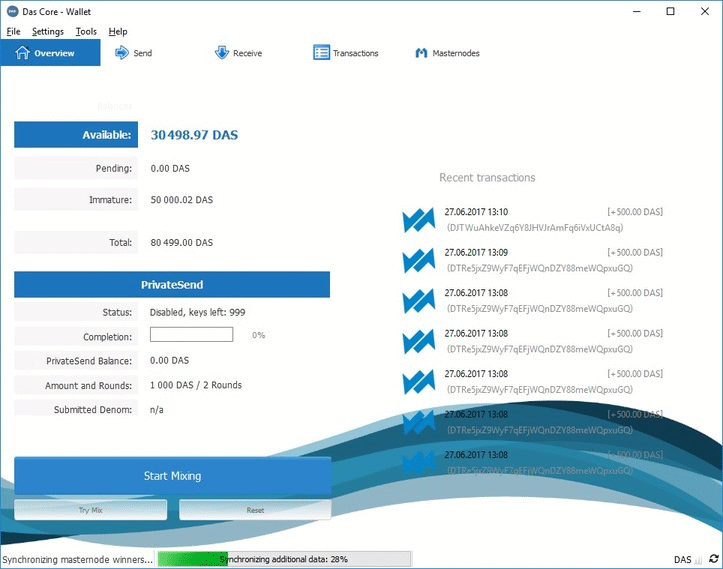Kimoto Gravity Well enabled!!!
Please update wallet and deamon!



PrivateSend Basics
PrivateSend gives you true financial privacy by obscuring the origins of your funds. All the Das in your wallet is comprised of different “inputs” which you can think of as separate, discrete coins. PrivateSend uses an innovative process to mix your inputs with the inputs of two other people, without having your coins ever leave your wallet. You retain control of your money at all times.
The PrivateSend process works like this:
PrivateSend begins by breaking your transaction inputs down into standard denominations. These denominations are 0.01 Das, 0.1 DAS, 1 DAS and 10 DAS -sort of like the paper money you use every day.
Your wallet then sends requests to specially configured software nodes on the network, called “masternodes.” These masternodes are informed then that you are interested in mixing a certain denomination. No identifiable information is sent to the masternodes, so they never know “who” you are.
When two other people send similar messages, indicating that they wish to mix the same denomination, a mixing session begins. The masternode mixes up the inputs and instructs all three users’ wallets to pay the now-transformed input back to themselves. Your wallet pays that denomination directly to itself, but in a different address (called a change address).
In order to fully obscure your funds, your wallet must repeat this process a number of times with each denomination. Each time the process is completed, it’s called a “round.” Each round of PrivateSend makes it exponentially more difficult to determine where your funds originated.
This mixing process happens in the background without any intervention on your part. When you wish to make a transaction, your funds will already be anonymized. No additional waiting is required.
IMPORTANT: Your wallet only contains 1000 of these “change addresses.” Every time a mixing event happens, one of your addresses is used up. Once enough of them are used, your wallet must create more addresses. It can only do this, however, if you have automatic backups enabled. Consequently, users who have backups disabled will also have PrivateSend disabled.
Code Review K.Atlas 2014
PrivateSend Technical Details (Advanced Users)
PrivateSend is a novel, decentralized mixer for creating an on-demand system of removing the history from coins on the network. This is mainly for fungablity, which is the attribute of money that allows any token to be exchanged with any other token, without having a difference in price in the form of a premium for tokens with less or no history. Without PrivateSend, tokens with less history would become increasingly valuable as the network grows, because of their lack of association with prior transactions. Without fungibility, there is a risk that certain tokens could be “red listed” and lose some or all of their value if at any point in the past they had been found to be used in illegal or questionable activities. Nobody wants to hold money that was involved in illegal activity, yet after the activities take place, tokens re-enter the supply and pass to new users who had no connection with the prior illegal acts. We remove this issue with the implementation of PrivateSend, which is included as part of the core protocol of the Das network.
PrivateSend Status Codes
The system has various modes which allow servers to keep track of the current state of their mixing pool. These mixingpools are single use, allowing three people to use them at a time. Statuses are idle, queued, accepting_entries, finalizing_transaction, signing_transaction and transmitting transaction.
Users begin by connecting to a node, which is in the idle state. The masternode then moves the wstatus to “queued” and issues a message to the network, telling other users that’s it’s currently available for mixing. Users can utilize multiple servers at a time to mix, what is called multi-session mixing. This greatly speeds up the mixing process at the cost of creating more addresses and thus requiring more frequent wallet backups.
Privacy Through Ambiguity
Mixing is the process of joining multiple transactions together, from multiple users, where all unique information about the users is removed from the transaction. Users send tokens to themselves through the system, and at no time do these tokens ever leave the users’ wallet. masternode operators are therefore completely separate from the process of mixing. masternodes simply serve as a transit method for the storing and signing of transactions, allowing users a safe place to initiate the process in an anonymous way.
Privacy is achieved by using denominated amounts of 100, 10, 1 or .1. Each session initiated on a masternode only carries a single denomination, such as having 10x 100D inputs and 10x 100D outputs. Users then individually sign their inputs to the collective outputs, allowing the transaction to be valid once complete and broadcastable.
Fee Model Anonymity
In other implementations of mixing software, fees can be used to break the transactions apart and identify users on the networks. On the Das Network this is avoided by allowing masternodes a special type of message which allows them to broadcast fee-less transactions. We use this technology to decouple the fees from the transactions, so that for every 10 transactions using the PrivateSend technology, there is only one fee transaction. This prevents a timing attack on the PrivateSend implementation.
Phases of PrivateSend
The process begins when a user denominates some funds to be used as a “cash account,” then they simply tell a random masternode they would like to mix a specific denomination such as 100D. The masternode has no information about the transaction at this point, since the denomination carries no information about which inputs the user would ultimately like to mix. The masternode receives the request and issues a message to the network saying that it is ready to mix that denomination and that there is a user waiting.
At this point if other users are wishing to mix inputs of that denomination, they can connect to the masternode that is hosting the other user’s transaction. When three users queue themselves on the same masternode, the next stage, “accepting_entries,” is initiated.
In this stage, all users send their inputs and outputs to the masternode, where they are collected and put into memory until all users have identified the full list of inputs/outputs they would like to mix. Once this is complete, the process moves onto the next stage, “finalize.” At this point, the masternode sends a message back to the users, showing the merged transaction they all jointly created. All inputs are from the user’s wallet and all outputs are sent back directly to the user’s wallet. The funds involved in this process never leave the user’s wallet at any time, allowing the masternode to be completely segregated from users’ funds. This is how the process of PrivateSend remains trustless and secure, without risking user’s funds or exposing masternodes to excessive legal risk. Once the finalized transaction is approved, the process moves onto the next phase, “signing.”
Users sign only the inputs for which they have keys, and the funds are then released to all outputs simultaneously. It’s worth noting that inputs and outputs are not directly tied to each other in this process, since inputs are in a separated list and only tied to each other. Outputs are also in a separated list, only tied to each other. This means, literally, that all users are paying all users in this process. The users are not only paying themselves, but everyone else. This means you can’t say input #4 went to output #14 (e.g. you can’t trace the input to the output, they are processed in concert).
When all inputs are signed to all outputs, the transaction suddenly becomes valid, and the masternode broadcasts using a special message called DSTX. The network keeps track of these messages, allowing masternodes to submit one PrivateSend transaction every N hours without paying fees.


InstantSend is a service that allows for near-instant transactions. Through this system, inputs can be locked to specific transactions and verified by consensus of the masternode network. Conflicting transactions and blocks are rejected. If a consensus cannot be reached, validation of the transaction occurs through standard block confirmation. InstantSend solves the double-spending problem without the longer confirmation times of other cryptocurriencies such as Bitcoin.

What are Masternodes:
Simply put, a Masternode is a server connected with the network that performs certain tasks related with PrivateSend, which is what the anonymity feature is called, and gets paid for it. It is Proof of Service.
Anyone can run a Masternode. The objective is to have enough of them for decentralization so nobody controls an important fraction of Masternodes. On the other hand, to avoid bloating the network or having reckless operators, there is one condition that needs to be fulfilled: proof of ownership of 1000 DAS. The coins don’t need to be in the Masternode, but they need to be kept in a certain way. If the owner moves or spends those coins, the Masternode stops working.
Masternodes are get paid by the network for the services they provide for PrivateSend. 20% of the new block’s reward goes to pay the Masternodes.
Masternodes are selected from the MN list (for MasterNode) by deterministic order (the one that got it’s payment the most time ago and has been in the list enough time at the same time),
so in the long term all Masternodes will converge to a similar amount of rewards.
Having so many servers with the full block chain working for the coin can be extremely useful. Thanks to the reward system, there is no risk of not having enough master nodes and the developers can rely on them for any new decentralized feature they want to implement. This is huge. Tell any developer that he can count on a thousand distributed servers working 24×7 for him and he will tell you.
The more Masternodes the better and safer for the DAS Network.
Please support The Masternode Network ! Do not let your DAS just sit in the Wallet, put them to work !
There are many services and guides (see bellow) to help you achieve your own Masternode. The payment returns speak for themselves, please check the chart bellow.
Welcome to the DAS Masternode Network, the best investment/return in the Crypto World.
The easiest way to start masternode

Dash fork
Decentralized Masternode Network
X11 hashing algorithm: 11 rounds of scientific hashing functions (blake, bmw, groestl, jh, keccak, skein, luffa, cubehash, shavite, simd, echo)
Block reward is controlled by: 2222222/(((Difficulty+2600)/9)^2)
CPU/GPU/ASIC mining
Block generation: 2.5 minutes
Premine 3.35%
InstantSend confirmation: ~5 seconds
Difficulty retargets using Dark Gravity Wave
Est. ~18.9M Max Coins
Superior Transaction Anonymity using PrivateSend

Linux wallet https://bitcointalk.org/index.php?topic=1988059.msg20138280#msg20138280

http://lpool.name/ (2% fee)
-o stratum+tcp://lpool.name:3533 -u <WALLET_ADDRESS> -p c=DAS
1% fee.
Hourly payouts.
Mining setup:
You can adjust difficulty. To set it to 2 (needed for nicehash), do this:
Explorer:
http://das.explorerz.top:3002/
http://lpool.name/explorer/DAS


2. Retweet https://twitter.com/DAS_Crypto/status/887657017971757056
3. Screenshot of the PM and the address to receive the reward.
5000 DAS per linux wallet.
DAS github pages: 3000 DAS.
Pool: 2000 DAS (In your pool should be at least 5 coins)
DAS Services: 1500 DAS
Adaptation DASH MASTERNODE SETUP GUIDE for DAS: 250 DAS
DAS forum and wallet design: 5000 - 15000 DAS. Depending on the quality of services.



